Translate this page into:
Silver nanoparticles blended PEG/PVA nanocomposites synthesis and characterization for food packaging
⁎Corresponding author. ravindran.ernest@kluniversity.in (R.S. Ernest Ravindran)
-
Received: ,
Accepted: ,
This article was originally published by Elsevier and was migrated to Scientific Scholar after the change of Publisher.
Peer review under responsibility of King Saud University.
Abstract
In this research investigation Silver nanoparticles were synthesised using rapid biological methods using leaf broth of Capparis zeylanica that provides an environmentally friendly, simple and efficient route for synthesis. Anti-microbial study was investigated against different pathogenic bacteria. Synthesized AgNPs were blended with PVA/PEG biopolymer blend and it has been confirmed by FTIR, DSC, Moisture absorption and Anti-microbial analysis that the AgNPs enhances the stability of the polymer PVA/PEG. This thin film composite shows an excellent characteristic in all aspect that able it for food packaging and bio medical applications.
Keywords
Silver Nanoparticles
Capparis Zeylanica
PVA
PEG
Nanocomposites
1 Introduction
Nanotechnology refers to the ability of constructing items from bottom up, using techniques and tools that are being developed today to make highly advanced products (Amit et al., 2010; Saranyaadevi et al., 2014a). Most definitions revolve around the study and control of phenomena and materials at length scales below 100 nm. The properties of material change as their size approaches nanoscale and as the percentage of atoms at the surface of a material becomes significant. Silver nanoparticles have unique optical, electrical, and thermal properties that are being incorporated into products for various application (Zhu et al., 2019; Saranyaadevi et al., 2014a; Subha et al., 2015; Kalainila et al., 2015; Sathyaa et al., 2017).
Biopolymers are extracted from living organisms which consist of biodegradable compound that is regarded as the most organic compound in the ecosphere. Biopolymers are sustainable as they are composed of living materials and these polymers can reduce the carbon dioxide levels in the atmosphere (Dhabale et al., 2012; Niraimathee et al., 2016; Kalainila et al., 2017; Samar et al., 2017).
Polymer blending is one of the most important contemporary ways for the development of new polymeric materials and it is a useful technique for designing materials with a wide variety of properties (Sathyaa et al., 2017; Zhan et al., 2019). The significant advantages of polymer blends are often exhibit properties that are superior compared to the properties of each individual component polymer. However, the manifestation of superior properties depends upon the miscibility of blend (Pencheva et al., 2012; Song et al., 2020). The actual tendency in packaging research is to develop and promote the use of “bio-plastics” which are useful in reducing waste disposal and are good replaces of petroleum, a non-renewable resource with diminishing quantities (Sahaa et al., 2014; Jamal Uddin et al., 2012). The problems in disposing of the huge quantities of waste generated by non-biodegradable food packaging have led to the study of biopolymers as materials to be used as edible coatings in food packaging (Bryaskova et al., 2010; Geng et al., 2020, Feng et al., 2020). Development of materials from natural polymers for different applications has been a hot topic for several years due to increasing prices of petrochemicals and increasing environmental concerns (Filippo et al., 2009; Saini et al., 2013; Ghaffari-Moghaddam and Eslahi, 2014; Gautama and Ramb, 2010; Ali, 2013). For more natural products, bio-based films or biopolymers, improving the quality of many products is important to satisfy the consumers demanding of more environmentally friendly packaging (Abdul Kareem and Anukaliani, 2011; Huang et al., 2019).
2 Materials and methods
2.1 Capparis zeylanica
Capparis zeylanica is commonly known as Indian caper a climbing scandant shrub found throughout India. Capparis zeylanicais belonging to the family capparidaceae as shown in Fig. 1 (Amit et al., 2010; Saranyaadevi et al., 2014a). Plants are in 2–3 m in height, armed with 3–6 mm long recurved thorns, branched, leaves are elliptic or broadly lanceolate, base rounded, apex mucronate (Saranyaadevi et al., 2014a). Flower profase, pinkish white, later turning pink, berries are globular or elliposide, 3–4 cm in diameter, and are globase, embedded in white pulp. Leaves and seeds contain thioglucosides, glucocapparin, n-tricontane, α-and β-amyrin, an alkaloid, a phytosterol, a mucilaginous substance and a water-soluble acid, capricacid (Amit et al., 2010). Leaves are used as a counter irritant and as a cataplasm in boils, swellings, piles and rheumatism. Capparis zeylanica has shown antibacterial activity, mainly against Gram-negative bacteria (Saranyaadevi et al., 2014a). Extracts of C. zeylanica leaves have shown antioxidant and hepatoprotective properties in pharmacological models. Athondai has shown some invitro anticancer, antiestrogenic, immunomodulatory, and antiamoebic activity (particularly against Entamoebahistolytica) (Saranyaadevi et al., 2014a; Dhabale et al., 2012). Capparis zeylanicaleaves were collected from surroundings areas of Mannargudi, Tamilnadu, India.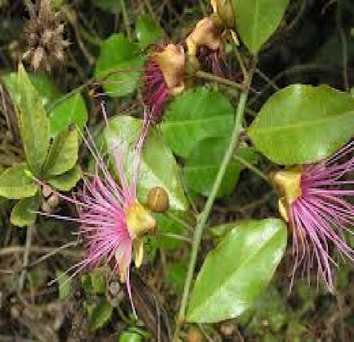
Capparis zeylanica.
2.2 Preparation of Capparis zeylanica leaf broth
AR grade silver nitrate (AgNO3) was purchased from Sigma-Aldrich chemicals and fresh Capparis zeylanica leaf extract used for the reduction of Ag+ ions to AgNPs was prepared by taking 20 g of thoroughly washed finely cut leaves in 500 ml flask along with 100 ml of distilled water and the mixture boiled at 60 °C for 20 min. Then the extract was filtered with Whatman No. 1 filter paper and stored at 4 °C (Saranyaadevi et al., 2014a).
2.3 Synthesis of nanoparticles
In a typical reaction procedure, 5 ml of plant leaves extract was added to 20 ml of AgNO3 (1 mM) solution at room temperature. The resulting solution become dark brown in colour after 60 min, indicating the formation of AgNPs. Then the extract was centrifuged at 8500 rpm for 35 min and subsequently dispersed in distilled water to get rid of any uncoordinated biological materials (Saranyaadevi et al., 2014a).
2.4 Preparation of PVA/PEG blend with nanoparticles
PVA (50%)/PEG(50%) films were prepared as follows: For each film, 2 g PVA was dissolved in 50 ml double distilled water under 80 °C and stirring for 2 h till the complete dissolution of PVA. 2 g PEG was dissolved in 50 ml of water at room temperature then mixed with PVA solution. The mixed solution stirred for another 1 h at room temperature. Then the nanoparticles samples were measured with different concentration were added into blend and stirred over complete mixing and it has been casted into glass Petri dishes and placed in an oven at 50 °C for 36 h in Hot air oven. Fig. 2 (a) shows the PVA/PEG thin film and (b) PVA/PEG with AgNPs (see Fig. 3).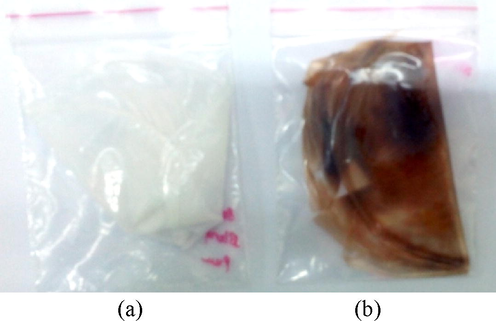
(a) PVA/PEG and (b) PVA/PEG blended with AgNPs.
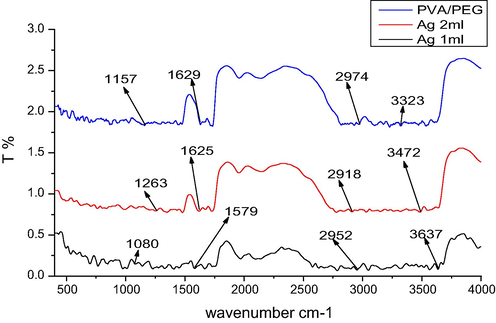
FTIR analysis of AgNPs + Polymer blend.
2.5 Characterization
Synthesized silver nanoparticles were confirmed at different time intervals and the absorption maxima was scanned by UV–Vis spectrophotometer at the wavelength of 300–800 nm on Perkin-Elmer Lambda 25. XRD pattern was measured by drop coated films of AgNO3 on glass plate and employed with X-ray diffractometer (INEL X-ray diffractometer) of characteristic Co-kα1 radiation (λ = 1.78 A°) in the range of 10–70° at a scan rate of 0.05°/min with the time constant of 2 sec.
FTIR spectrum was recorded in the range of 4000–400 cm−1 using Thermo Nicolet Nexus 670 spectrometer in the diffuse reflectance mode operating at resolution of 4 cm−1. SEM observations were carried out on a ZEISS EVO 40 EP Electron microscope. Morphology and size of the silver nanoparticles were investigated by TEM images using HITACHI H-7650 at an operating voltage of 80 kV instrument.
Addition of salts, plasticizers and fillers to the polymer host results in interactions and/or complexation of the host polymer matrix. This will influence the local structure of polymer back- bones and significantly affects the immobility. In this context, infrared spectroscopy studies will give the evidence of possible complexation and interactions. Infrared spectra were recorded with a Nicolet 5 DXC spectrometer. Thin films were prepared by the solution casting method. All the samples were annealing at 140 °C for 2 h to remove the residual solvent and to make the polymer blend mixing complete. A minimum of 32 scans was signal averaged with a resolution of 2 cm−1 at 150 °C. The hydroxyl stretching region of the IR spectrum was analyzed for the varied phenolic blends.
Thermal behaviour of the composites were analysed by Differential Scanning Calorimeter Perkin– Elmer DSC-7. Samples with a mass of about 10 mg were used with heating step from 0 to 260 °C at a rate of 10 °C/min followed by an isothermal heating for 10 min, a first cooling from 260 to 0 °C, and a second heating in the same range. All DSC runs were carried out under nitrogen atmosphere to minimize the oxidative degradation.
Moisture Absorption test is used to determine the moisture absorptivity of the material. In order to determine the moisture absorption, samples of square pieces of the polymer films (2 cm diameter) were placed on a desiccator’s tray which contains initially CaCl2. After 24 h the weight of the samples was measured and taken it as initial weight. Then the Ca(NO3)2 was taken instead of CaCl2 for the complete moisture absorption of the biopolymer composites. The weight of the samples was measured at various time interval. The films were then quickly placed back on the desiccator’s tray. The process was repeated until the films attained constant weight after a certain period. The percentage of moisture absorption was calculated from the equationgiven below, where MA is moisture absorption in %, MF is final weight of the polymer in g and MI is initial weight of the polymer in g respectively.
The antimicrobial activity of the developed Agbio-films was tested by disc diffusion method against Escherichia coli, Pseudomonas Aeruginosa, Staphylococcus aureus. In disc diffusion method, the films are cut into a disc shape with 5 mm diameter, sterilized by autoclaving for 30 min at 120 °C, and placed on different cultured agar plates. The plates are incubated for 2 days at 37 °C in an incubation chamber maintaining with 5% CO2 flow and the inhibition zone is then measured.
3 Results and discussion
3.1 FTIR – spectroscopy analysis
FTIR spectra of AgNPs blend shown in Fig. 7. The peak at 3200–3650 cm−1 indicates the presents of OH group is engaged in the formation of hydrogen bond or complex with metal particles (Pencheva et al., 2012; Sahaa et al., 2014; Bryaskova et al., 2010; Bryaskova et al., 2010; Filippo et al., 2009). The presents of C-H and CH2 bonds in Alkanes which are in the PVA structure was confirmed with the intense bonding peaks around 2700–3000 cm−1 and 1550–1650 cm−1 respectively (Pencheva et al., 2012). Absorption band due to C⚌O stretching of the Ester group of the (blend) PVA/PEG can be seen at peaks around 1050–1300 cm−1.
3.2 DSC analysis of composites
The glass transition temperature (Tg) of the polymer blend films were determined by Differential Scanning Calorimeter. The scan rate was 20 °C/min within a temperature range of −70 to 250 °C. The measurements were made with 3 mg samples on DSC sample plates after the specimens were quickly cooled to −70 °C following the first scan. This procedure was adopted to ensure a complete mixing of the polymer blends and to remove the residual solvent and water in the specimen completely. The glass transition temperature and melting point of the PVA/PEG blend was 78.8 and 187.6 °C shows from the Fig. 4. The Tg and melting point values was increased when the nanoparticles are added into the polymer blend (Saini et al., 2013; Ghaffari-Moghaddam and Eslahi, 2014; Gautama and Ramb, 2010; Ali, 2013; Abdul Kareem and Anukaliani, 2011).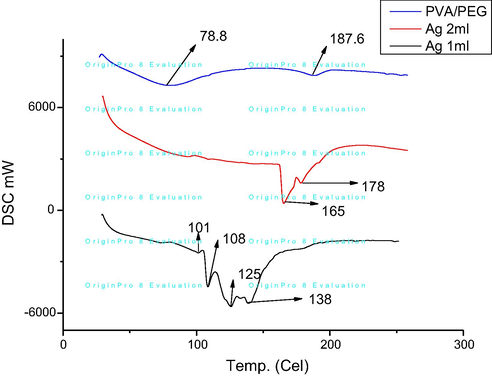
DSC analysis of PVA/PEG, PVA/PEG + AgNPs.
3.3 Moisture absorption test
Moisture Absorption test is used to determine the moisture absorptivity of the material. From the Fig. 5moisture absorption value of the composite increased with higher composition of nanoparticles in the biopolymer. The result shows that the composite is thicker when the nanoparticles are added into the biopolymer blend which indicates the percentage of moisture absorption depends the concentration of nanoparticles in blend.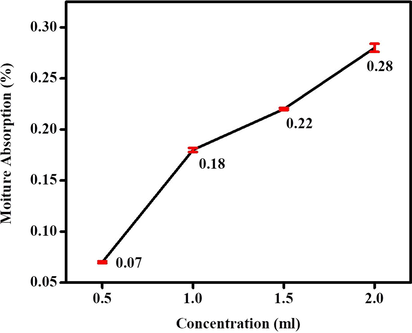
Moisture absorption of AgNPs in biopolymer.
When the silver nanoparticles composition increases the moisture absorption content initially increases, usually when the moisture content increases, the permeability of microbes on the polymers which allows the degradation of biopolymers usually. But in case of AgNPs blend increases the antimicrobial activity also increases. Hence less/or no degradation could have occur, which will leads to self-life of the biopolymers and increases the food self-life also.
3.4 Antimicrobial study of composites
Bacterial sensitivity to antibiotics is commonly tested using a Disk diffusion method. The antimicrobial activity was done on various pathogenic bacteria like Escherichia coli, Pseudomonas Aeruginosa, Staphylococcus aureus. Nutrient agar medium was used to cultivate Bacteria. The pure cultures of bacteria were sub-cultured on nutrient agar medium. After solidification of medium, the species are spread over the medium using L-rod. Then the disks were placed on the medium. Freshly prepared Silver bio composite samples were added into the disks that were made in the seeded plates. The samples were incubated for 24 h at 37 °C. Positive test results were scored when a zone of inhibition was observed around the disk after the incubation period. The zone of inhibition values of blend with silver nanoparticles were shown in Fig. 6. The maximum zone of inhibition value was obtained for Pseudomonas Aeruginosa with 1.5 ml concentration of AgNPs (Saranyaadevi et al., 2014a).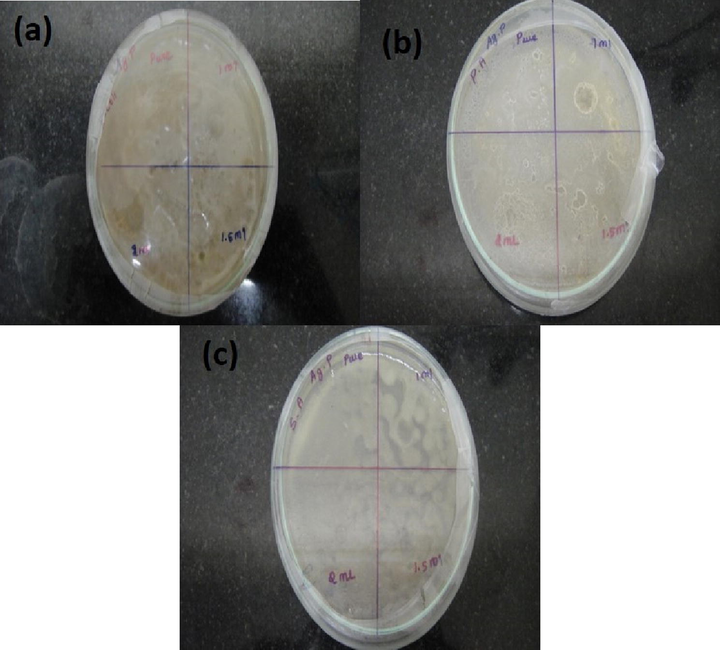
Antimicrobial activity of AgNPs + blend - E-Coli (a), Pseudomonas Aeruginosa (b), Staphylococcus Aureus (c).
4 Conclusion
The rapid biological synthesis of silver nanoparticles using leaf broth of Capparis zeylanica provides an environmentally friendly, simple and efficient route for synthesis of benign nanoparticles. Anti-microbial study was investigated against different pathogenic bacteria. The synthesized nanoparticles were mixed with PVA/PEG biopolymer blend has been confirmed by the characterizations of FTIR, DSC, Moisture absorption and Anti-microbial analysis. From the above analysis prepared composites were suitable for food packaging applications.
References
- Synthesis and thermal study of octahedral silver nano-plates in polyvinyl alcohol (PVA) Arabian J. Chem.. 2011;4:325-331.
- [Google Scholar]
- Synthesis and characterization of Ag0/PVA nanoparticles viaphoto- and chemical reduction methods for antibacterial study. Colloids Surf. A: Physicochem. Eng. Aspects. 2013;436:922-929.
- [Google Scholar]
- Phytochemistry and pharmacological activities of Cappariszeylanica: an overview. Inter. J. Pharma. Anal. Res.. 2010;1(2):384-389.
- [Google Scholar]
- Synthesis, characterisation and antibacterial activity of PVA/TEOS/Ag-Np hybrid thin films. J. Colloid Interface Sci.. 2010;349:77-85.
- [Google Scholar]
- Physicochemicals and phytochemicals evaluation of Capparis Zeylanica LinnInter. J. Pharma. Sci. Res.. 2012;3(1):198-200.
- [Google Scholar]
- Facile synthesis of Ag/Pd nanoparticle-loaded poly(ethylene imine) composite hydrogels with highly efficient catalytic reduction of 4-nitrophenol. ACS Omega. 2020;5:3725-3733.
- [Google Scholar]
- Poly(vinyl alcohol) capped silver nanoparticles as localized surface Plasmon resonance-based hydrogen peroxide sensor. Sens. Actuat. B. 2009;138:625-630.
- [Google Scholar]
- Preparation and thermomechanical properties of Ag-PVA nanocomposite films. Mater. Chem. Phys.. 2010;119:266-271.
- [Google Scholar]
- In situ construction of Ag/TiO2/g-C3N4 heterojunction nanocomposite based on hierarchical co-assembly with sustainable hydrogen evolution. Nanomaterials. 2020;10:1-13.
- [Google Scholar]
- Synthesis, characterization and antibacterial properties of a novel nanocomposite based on polyaniline/polyvinyl alcohol/Ag. Arabian J. Chem.. 2014;7(5):846-855.
- [Google Scholar]
- Facile preparation of hierarchical AgNP-loaded MXene/Fe3O4/polymer nanocomposites by electrospinning with enhanced catalytic performance for wastewater treatment. ACS Omega. 2019;4:1897-1906.
- [Google Scholar]
- Black tea leaf extract derived Ag nanoparticle-PVA composite film: structural and dielectric properties. Mater. Sci. Eng.. 2012;B 177:1741-1747.
- [Google Scholar]
- Anti-Bacterial effect biosynthesized silver nanoparticles using Kigelia Africana. J. Nanosci. Nanoeng.. 2015;1(4):225-232.
- [Google Scholar]
- Greener synthesis of silver nanoparticle from Chordia Dichotoma leaf extract and its antimicrobial activity. Int. J. Nanopart.. 2017;9(2):132-142.
- [Google Scholar]
- Green Synthesis of iron oxide nanoparticles from mimosa pudica root extract. Int. J. Environ. Sustainable Develop.. 2016;15(3)
- [Google Scholar]
- Polyvinyl alcohol/silver nanoparticles (PVA/AgNps) as a model for testing the biological activity of hybrid materials with included silver nanoparticles. Mater. Sci. Eng. C. 2012;32:2048-2051.
- [Google Scholar]
- Synthetic Ultrasound assisted green synthesis of poly(vinyl alcohol) cappedsilver nanoparticles for the study of its antifilarial efficacy. Appl. Surf. Sci.. 2014;288:625-632.
- [Google Scholar]
- Tailoring of electrical, optical and structural properties of PVA by addition of Ag nanoparticles. Mater. Chem. Phys.. 2013;139:802-810.
- [Google Scholar]
- Green synthesis of copper nanoparticle from passiflora foetida leaf extract and its antibacterial activity. Asian J. Pharm. Clin. Res.. 2017;10(4):79-83.
- [Google Scholar]
- Synthesis and characterization of copper nanoparticle using CapparisZeylanica leaf extract. Int. J. Chem. Technol. Res.. 2014;6(10):4533-4541.
- [Google Scholar]
- Silver nanoparticles from methanolic stem extract of Gymnemasylvestre and its characterization studies. Int. J. Nano Biomater. 2017
- [Google Scholar]
- Multifunctional antimicrobial biometallohydrogels based on amino acid coordinated self-assembly. Small. 2020;16:1907309.
- [Google Scholar]
- An eco-friendly approach for synthesis of silver nanoparticles using ipomoea pes-caprae root extract and their antimicrobial properties. Asian J. Pharm. Clin. Res. 8. 2015;5:1-4.
- [Google Scholar]
- Facile solvothermal preparation of Fe3O4–Ag nanocomposite with excellent catalytic performance. RSC Adv.. 2019;9:878-884.
- [Google Scholar]
- A facile preparation method for new twocomponent supramolecular hydrogels and their performances in adsorption, catalysis, and stimuliresponse. RSC Adv.. 2019;9:22551-22559.
- [Google Scholar]







